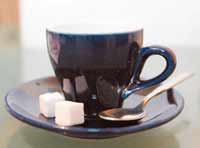Artificial sweeteners provoke body fat accumulation
Artificial sweeteners that many people use every day when having tea or coffee prove to be even worse than pieces of sugar, a new study finds.

A group of scientists conducted an experiment on lab rats. They fed the rodents with yoghurts sweetened with no-cal saccharin. As a result, the rats ate more food, gained weight and body fat as opposed to a group of other rats where had been given yoghurt containing plain glucose.
Scientists concluded that artificial sweeteners push the brain towards reviving the body’s metabolism as it starts to realize that calorie-rich food will never come.
When the tongue senses something sweet, it sends a signal to the brain to prepare the digestive system for a caloric load. However, expectations prove to be false with an intake of sweeteners. As a result, the body develops appetite problems when other food arrives.
"The data clearly indicate that consuming a food sweetened with no-calorie saccharin can lead to greater body-weight gain and adiposity [fat] than would consuming the same food sweetened with a higher-calorie sugar," the authors write in the journal Behavioral Neuroscience.
Saccharin is the oldest artificial sweetener. The basic substance, benzoic sulfinide, was produced in 1878 by Constantin Fahlberg, a chemist working on coal tar derivatives in Ira Remsen's laboratory at the Johns Hopkins University, and it was he who, accidentally, discovered its intensely sweet nature. Fahlberg and Remsen published articles on benzoic sulfinide in 1879 and 1880. In 1884, now working on his own in New York City, Fahlberg applied for patents, in several countries, describing methods of producing this substance that he named saccharin. Fahlberg would soon grow wealthy, while Remsen merely grew irate, believing that he deserved credit for substances produced in his laboratory. On the matter, Remsen commented, "Fahlberg is a scoundrel. It nauseates me to hear my name mentioned in the same breath with him."
In the European Union, saccharin is also known under the E number (additive code) E954.
Saccharin is about 300 times as sweet as sucrose, but has an unpleasant bitter or metallic aftertaste, especially at high concentrations. Unlike the newer artificial sweetener aspartame, saccharin is stable when heated, even in the presence of acids. It does not react chemically with other food ingredients, and stores well. Blends of saccharin with other sweeteners are often used to compensate for each sweetener's weaknesses. A 10:1 cyclamate:saccharin blend is common in countries where both these sweeteners are legal; in this blend, each sweetener masks the other's off-taste. Saccharin is often used together with aspartame in diet soda, so that some sweetness remains should the fountain syrup be stored beyond aspartame's relatively short shelf life. Saccharin was an important discovery, especially for diabetics, as it goes directly through the human digestive system without being digested. It has effectively no food energy. It has been shown 1, 2 that saccharin can affect insulin levels (which can indirectly cause weight gain).
Subscribe to Pravda.Ru Telegram channel, Facebook, RSS!


